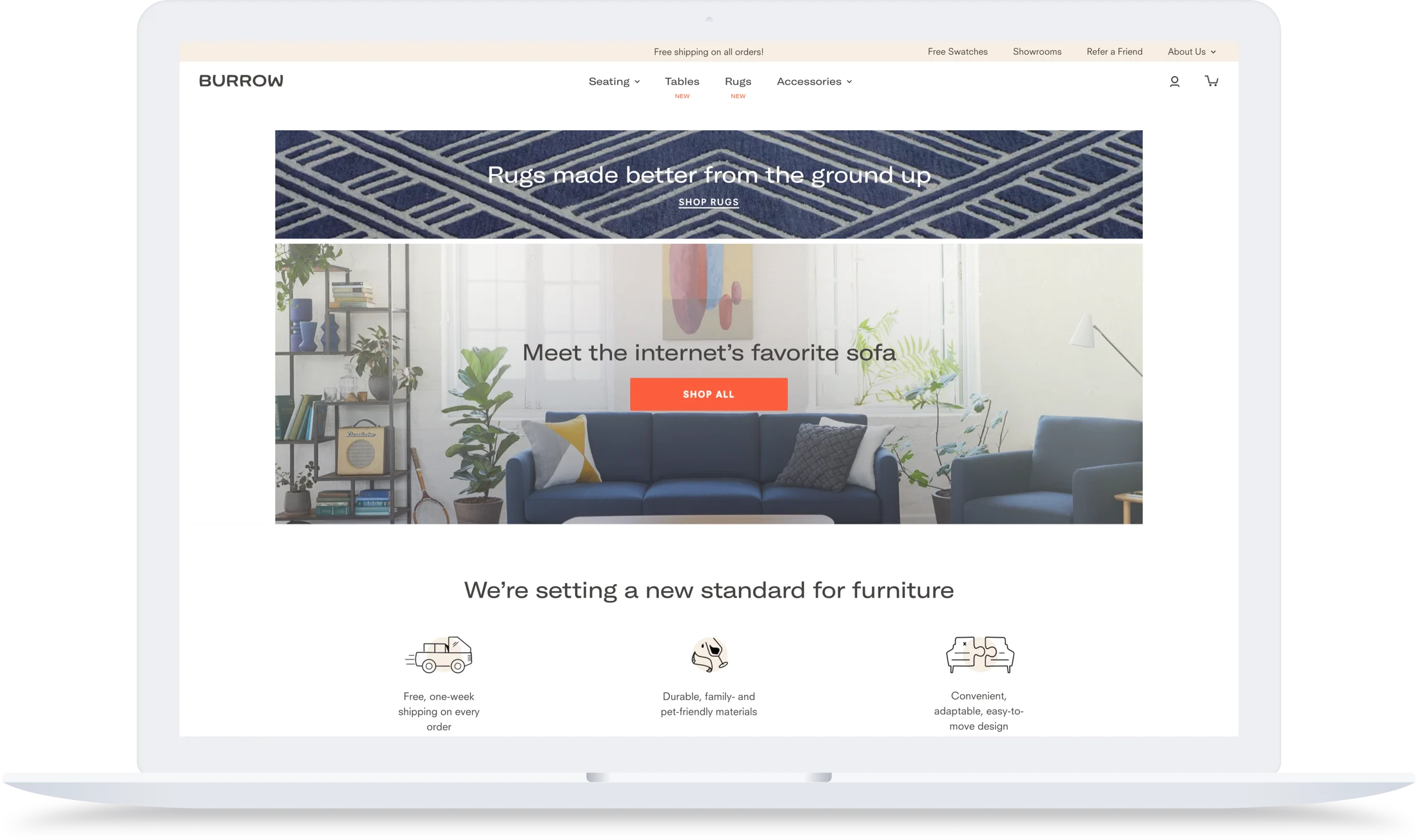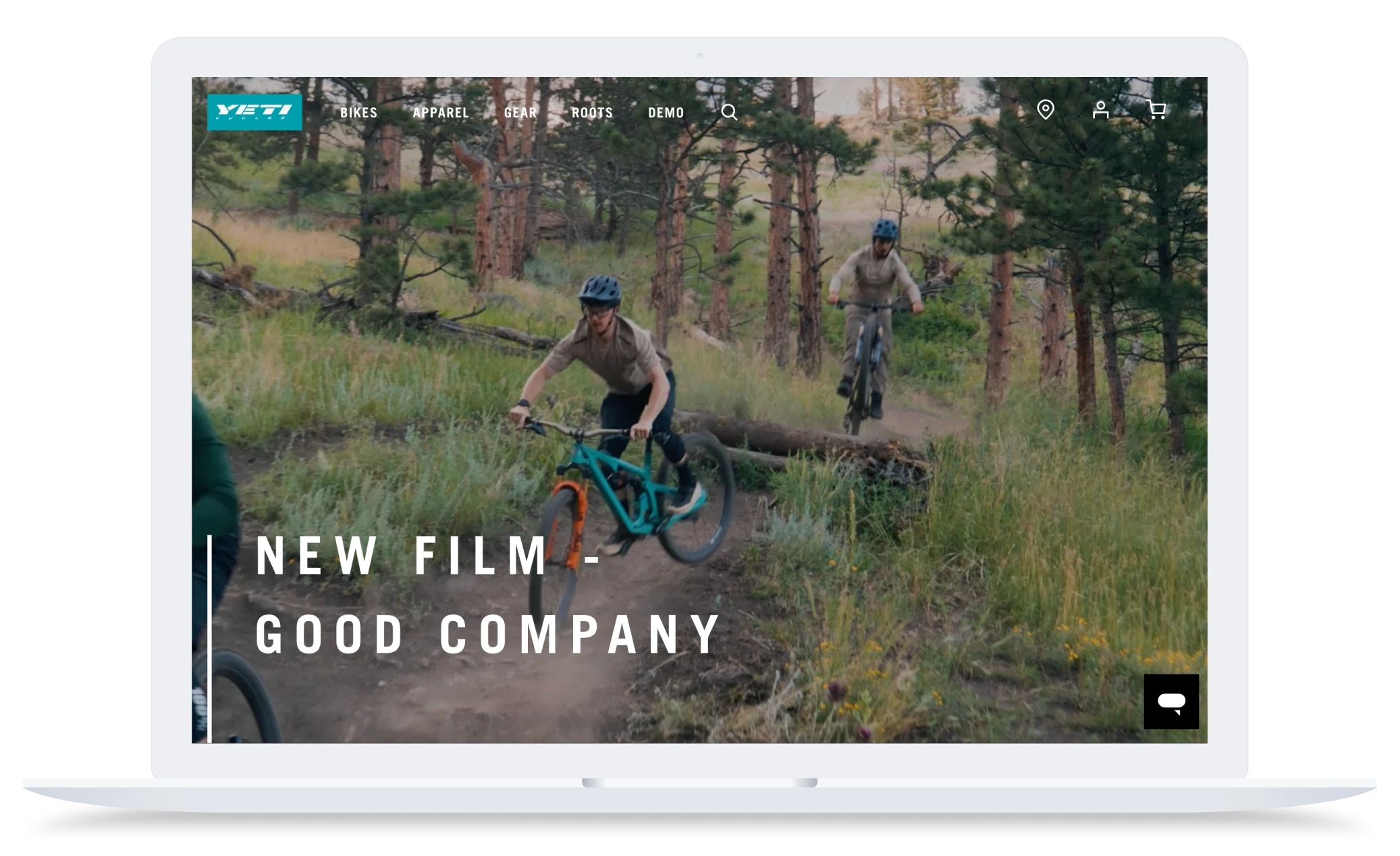
Composable Commerce
Get The Print Version
Tired of scrolling? Download a PDF version for easier offline reading and sharing with coworkers.
A link to download the PDF will arrive in your inbox shortly.
by Haylee Reed
08/20/2024
Today’s enterprises need flexible commerce solutions — solutions that can bend, stretch, and transform along with the ever-evolving nature of modern business.
However, this kind of agility can be difficult for many ecommerce businesses to achieve with their current tech stack. Historically, many retailers have built their online stores using traditional monolith ecommerce platforms — which not only hinder your ability to deliver cutting-edge shopping experiences, but also limit what teams can accomplish.
The solution? Composable commerce.
As of March 2023, 72% of US retailers had already implemented composable solutions, and another 21% were planning to adopt them over the following year. Undoubtedly, the ecommerce landscape is shifting away from legacy technologies and toward a more flexible, modular technology strategy.
In this article, we’ll explore why adopting a composable commerce approach can empower online retailers (as well as its potential challenges) and how BigCommerce can help you build a future-proof commerce solution.
What is composable commerce?
Coined by Gartner in 2020, composable commerce is a modular approach that allows businesses to tailor their tech stacks with best-of-breed solutions to suit their unique business requirements. At the core of this approach are Packaged Business Capabilities (PBCs), which are pre-configured modules that deliver specific business functions.
Thus, composable architectures essentially provide a “box of Legos” for your business — meaning you can choose your preferred technologies for each specific business need, which can then be assembled into a custom, agile tech stack.
There are four key tenets of composable commerce:
Modular: Each component of the system can be deployed and interchanged independently.
Open: Applications can be seamlessly integrated with all other applications in the system, with no vendor lock-in.
Flexible: With your unique stack, you can create unique commerce experiences tailored precisely to your business.
Business-Centric: This system allows merchants to quickly and cost-effectively respond to changing business requirements.
Explore Catalyst, the future of storefront experience.
Experience the storefront that's setting a new standard for modern commerce, designed for your whole team to love.
What is the value of Packaged Business Capabilities (PBCs)?
Venturing away from the all-in-one monolithic approach, composable commerce is achieved by assembling and combining Packaged Business Capabilities (PBCs).
PBCs are software components that meet specific business capabilities — such as a virtual shopping cart, order management, or account management — and communicate with one another via application programming interfaces (APIs). They are meant to be functionally complete and can be used as building blocks for applications and custom-assembled application experiences.
Let’s look at a few ways that PBCs provide value for ecommerce businesses.
Simplifies complex systems.
Especially if you’re a larger enterprise retailer, chances are you’re dealing with some complex systems in your tech stack. Luckily, PBCs help streamline the management of intricate systems by breaking them down into modular, self-contained components. This approach simplifies integration and scalability, allowing you to efficiently handle complex ecommerce environments with ease.
Reporting and dashboard friendly.
Since PBCs integrate seamlessly across your tech stack, you’ll be able to consolidate reporting and dashboard capabilities across the entirety of your systems — into one unified view. This provides you with actionable insights and comprehensive data points, enabling better decision-making across your entire ecommerce ecosystem.
Inspires collaboration between teams.
With PBCs, you can drive impactful business benefits through company-wide innovation. Greater levels of agility let teams pivot swiftly — when teams have new ideas, they can be quickly implemented without the potential for widespread disruption.
Benefits of composable commerce
By breaking down the monolithic barriers of traditional systems, composable commerce unlocks the potential for innovation, efficiency, and growth, allowing businesses to craft unique, customer-centric journeys that drive results.
Let’s take a look at four key ways that composable solutions can boost your ecommerce business.
Flexibility and agility.
Rather than relying on one vendor for all of your business requirements, composable commerce allows businesses to choose best-in-breed vendors to create a robust, functional technology stack.
This also means that businesses have the flexibility to customize their tech stack — from your shopping cart to your CRM to your checkout — rather than simply being told “no” when a requirement isn’t precisely met by the platform.
Enhanced customer experience.
Along with the flexibility to deploy and interchange modules, you also have the freedom to deliver cutting-edge shopping experiences. No longer bound to legacy technologies and monolith systems, your team can create unique commerce experiences tailored to your clientele.
Scalability and innovation.
As your business scales and changes, your modular tech stack will expand along with it.
Composable commerce means that, should your business want to replace other commerce components down the line, they’re never locked into a system or a way of doing things — in essence, it’s how your business can build for the future.
Cost-effectiveness and efficiency.
Composable architectures allow you to choose best-in-breed solutions that meet your specific business needs, which means less time and resources spent on unnecessary technologies.
Plus, composable systems make more things possible with less friction — fewer intended consequences, lower costs and increased innovation.
MACH architecture: The foundation of composable commerce
To evaluate a technology to understand if it truly is a composable solution, look to the industry tech standard of MACH.
In 2020, a community of developers formed the MACH Alliance to help enterprises navigate the modern technology landscape, advocating for open technology ecosystems. Their community perspective on building these open environments is based on four key principles:
Microservices-based: The building blocks of your tech stack, which offer a decentralized, decoupled approach to meeting individual business requirements.
API-first: All commerce functionality is connected and accessible via APIs, providing seamless integration and communication between systems.
Cloud-native: Fully leverages the cloud for speed, performance, and security, providing fast, reliable experiences to your customers.
Headless: Decouples the frontend presentation layer from the backend commerce engine.
How adopting composable commerce can improve your online store
As technology evolves and retail finds new ways to innovate, businesses must be poised to react quickly to (and even anticipate) changing customer expectations.
Luckily, composable commerce’s modular approach offers businesses the agility needed to deliver best-in-class experiences at speed and scale — and differentiate themselves from a growing number of competitors.
Build personalized end-to-end customer experiences.
Customer journey touchpoints have expanded from “in-store” and “online” to social channels, marketplaces, IoT devices, and more. Shoppers are interacting with brands in contexts and mediums never seen before.
Building a user experience with these factors in mind requires a level of flexibility not necessary or feasible through a monolithic system — and composable commerce can help.
Respond rapidly to changing business needs.
Under a monolithic system, any change to functionality can be complex. On the other hand, composable commerce lets you address only the functionality that you need to grow — without the risk of impacting other business capabilities within your ecosystem.
Reduce customer acquisition costs.
Due to increasingly saturated advertising channels and changing consumer perceptions of advertising, customer acquisition costs are on the rise. A modular approach, however, allows for agile integration with the technologies needed to build lasting customer relationships and engagement.
Avoid vendor lock-in.
Monolithic software vendors often limit their clients’ flexibility. Discover a better product from a different company? You’ll have to wait until your contract expires — or buckle up for a potentially expensive replatforming process.
With a modular build, you can swap components in and out when it makes sense for your business.
Composable commerce challenges to consider
Needless to say, there are many perks to taking a composable commerce approach, especially for enterprise-scale businesses. However, there are some potential challenges to keep in mind when it comes to composable commerce — let’s dig in.
You have to manage multiple vendors.
There’s one advantage to a monolithic platform: you only have to deal with one vendor.
Negotiating terms of enterprise subscriptions, reviewing terms and conditions, integrating with the software — it takes much longer to do this when you’re looking at upwards of 40 to 50 vendors versus just a few. But with an Open SaaS composable ecosystem, you can streamline your vendor management.
Requires complex digital maturity levels.
“Think of microservices like Lego blocks without an instruction manual to piece them together to build that creation you had perfectly envisioned,” said Jimmy Duvall, former Chief Product Officer at BigCommerce.
Composable commerce is a complex business model that requires a digitally mature organization and deep, cross-functional collaboration among sophisticated developers.
Investing in infrastructure and monitoring tools.
Switching to a composable architecture might change the infrastructure and tools you need to monitor your various microservices. Be aware of what changes will be required and factor them into the total cost of ownership — and develop relationships with partners who can support your growing needs.
Implementing DIY control panels.
A pure microservices or completely headless experience requires merchants to build a cohesive user interface on top of other components. Because everything lives in different systems, tasks made simple by a more out-of-the-box platform become much more difficult to manage.
Build a future-proof composable solution with BigCommerce
If you’re ready to take the leap to a composable solution, look no further than BigCommerce.
We’re laser-focused on one thing — enabling enterprises with a future-ready, future-fit ecommerce platform. As a member of the MACH Alliance, BigCommerce subscribes to a best-in-breed approach, offering the flexibility and extensibility that enables businesses to compose the best commerce system for their specific needs.
Not only is over 90% of our platform exposed to APIs, but we also recently launched Catalyst, our new composable starter kit — which blends the flexibility of open source with the security and scalability of SaaS. With a fully integrated storefront reference implementation based on Next.js and React, Catalyst provides a full, end-to-end guest shopper experience that is pre-wired to our platform.
“Catalyst introduces BigCommerce’s reference composable architecture, equipping developers with the most preferred, highest performing technology, and brand users with the world’s best no/low-code Next.js visual editor,” said Brent Bellm, CEO at BigCommerce. “This new reference architecture serves as a composable starter kit to help customers launch faster and with greater success. Our partners now have a simplified gateway to offer their clients a comprehensive ecommerce solution that easily unlocks the full potential of composability on the BigCommerce platform.”
Composable commerce success stories
Regardless of any potential challenges of composable commerce, one thing is certain: it provides real results — and we have the stories to prove it.
Let’s take a look at some thriving BigCommerce customers to see how composable commerce took them to the next level.
Burrow.

As a brand specializing in modular, customizable furniture, Burrow needed a composable commerce architecture that would reflect this same flexibility. After reaching $3 million in sales in 2017, the team sought a modular, flexible ecommerce solution that could keep up with business growth.
Turning to BigCommerce, Burrow found the scalable backend system it needed to customize its site quickly and easily. The low maintenance of the platform freed up its team to focus more on marketing-focused updates to the site, and they could utilize a custom CMS (content management system) on the frontend, enabling them to create the kind of digital experiences they wanted for their customers.
Just Sunnies.

Just Sunnies, a leading provider of high-quality eyewear, has served the local community for over 17 years through their brick-and-mortar locations and online store. But as the business grew, their original ecommerce platform began showing its age. So, they went off in search of a new platform that could help create a unified, scalable ecommerce experience — and found it in BigCommerce.
With their new composable tech stack, Just Sunnies can implement new technologies and features across their website using a unique mix of external tools and custom-built front-end solutions. As a result of the migration, Just Sunnies has seen a 15% increase in sales, a 32% increase in visits, and a 21% increase in conversion rate.
MKM.

MKM Building Supplies, the UK's largest independent brand for builder supplies, embarked on a significant digital transformation project that showcased the blueprint for establishing a robust B2B ecommerce presence.
To meet the needs of a younger, mobile-first audience, MKM adopted a MACH-based, headless architecture, enabling the business to build a tailor-made and future-proof tech stack.
“Using headless technology meant we could do rapid improvements and change directions quickly, adding new features or categories without being limited by the technology,” said Andy Pickup, Digital Director at MKM Building Supplies.
Black Diamond.

Black Diamond leveraged composable commerce to integrate content and stories throughout their ecommerce site. For example, if a shopper was looking to read stories about the brand’s ambassadors or athletes, they are presented with a clear path from the homepage to quickly get to content or products. This design ensures that the essence of the Black Diamond brand is ever-present throughout the site experience.
While content and commerce are connected on the site, behind the scenes, the separation of the frontend and backend enables Black Diamond’s US and EU marketing teams to have direct access and capability to manage the site and campaigns — without having to rely on developers to make changes.
Yeti Cycles.

Yeti Cycles, a leading manufacturer of mountain bikes, needed an online experience that matched the one they provide offline. The team knew that, if they wanted to grow, they would need a more integrated backend that could connect their systems and help propel their brand forward more efficiently.
Turning to BigCommerce, they decided that leveraging a headless framework would not only set them up for success in the present, but also the future.
“WIth BigCommerce, we're not just stuck with what’s there out of the box,” said Matt Hicks, Director of Technology and Customer Experience at Yeti Cycles. “We can innovate easily, which I love. And that goes for customization, too. Our time to market has increased dramatically.”
Final Word
While a one-size-fits-all solution might be a quick fix for today’s roadblocks, a monolithic platform won’t sustain businesses in the long-term. Today’s businesses need a composable commerce solution that provides the flexibility and agility needed to respond quickly to unexpected market changes.
The right time for adopting a composable architecture is now. With BigCommerce as your platform, you’ll have a trusted partner that will enable you to deliver cutting-edge commerce experiences today — and into the future.
FAQs about composable commerce

Haylee Reed
Haylee is a Content Marketing Writer at BigCommerce, where she partners with the SEO team to craft narratives and blog content. She earned a B.A. in English Literature from the University of Texas at Austin and afterward spent a year abroad to pursue a Master's in International Management from Trinity College Dublin. When she’s not writing, you can usually find Haylee with her nose in a book, enjoying live music or scoping out the best local coffee shops.



